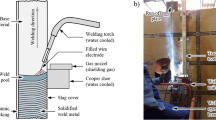Abstract
This is a study of the influence of centrifugal process on the graphite morphology, mechanical and wear properties on flake graphite iron (FGI), spheroidal graphite iron (SGI) and compacted graphite iron (CGI). Melts of hypereutectic and almost of identical composition with or without melt treatment were centrifugally cast. The microstructure, mechanical and wear properties of these specimens were studied. In the microstructure for FG iron it has been observed that the centrifugal process produces flake size range class 2–3 (range 160–320 μm) and graphite of flake type A by about 67.9 % (field %) and combined flakes of type B, C, D and E will be of 32.1 % (field %). While SGI has been observed to have 96.1 % nodules and 330.0 nodules per square millimeter. Similarly CGI has been seen to produce 52.0 % nodules and 113 nodules per square millimeter. SGI possess the highest tensile strength, rupture strain and hardness of 604 N/mm2, 6.1 %, 233 BHN respectively. Whereas FGI possess the least tensile strength, rupture strain and hardness of 303 N/mm2, 0.65 %, 185 BHN respectively among the irons. CGI has a tensile strength, rupture strain and hardness of 369 N/mm2, 1.2 % and 200 BHN respectively which lies in between those of FGI and SGI. During the wear test similar materials for both disk and pin combination show higher co-efficient of friction and wear rate than those for dissimilar material combinations. SGI disk and FGI pin combination show least wear. This combination would be ideally suited for engine liner and piston rings.















Similar content being viewed by others
References
Torsten Sjogren, Influence of Graphite Phase on Elastic and Plastic Deformation Behaviour of Cast Iron, Ph D Thesis, Linkoping University, (2007) p 5.
Ganwarich Pluphrach, Songklanakarin J Sci Technol 32 (2010), p. 613.
Davis J R, In ASM specialty handbook, 1st edition, ASM International, Metals Park, Ohio (1996) p 356.
Baicchi P, Collini L, and Nicoletto G, Influence of foundry practice on mechanical properties of gray cast iron, in Proceedings of 4th Youth Symposium on Experimental Solid Mechanics, (2005) 4–7.
Stefanescu D M, Mater Sci Eng A 413–414 (2005) 322.
Collini L, Nicoletto G, and Konecna, Mater Sci Eng 488 (2008) 529.
Stefanescu D M, Theory of Solidification and Graphite Growth in Ductile Iron, Cast Metals Institute (1992) p 1.
Shayesteh-Zeraati A, Naser-Zoshki H, Kiani-Rashid A R, and Yousef-Sani M R, The Effect of Aluminium Content on Morphology, Size, Volume Fraction, and Number of Graphite Nodules in Ductile Cast Iron, 224 (2010) p 117.
Stefanescu D M, Ruxanda R, Dix L P, Int J Cast Metals Res 16 (2003) 319.
Meng-Bin Lin, Chaur-Jeng Wang, Alex A Volinsky, Oxid Met 76 (2011) 161.
Riposan I, Chisamera M, Kelley R, Barstow M, Naro R L, Magnesium–Sulfur Relationships in Ductile and Compacted Graphite Cast Irons as Influenced by Late Sulfur Additions, ASF Transactions 03-093, (2003) p 1.
Prasad B K, Wear 260 (2006) 1333.
Prasad B K, Tribol Int 44 (2011) 660.
Huteching I M, Arnold E, Friction and Wear of Engineering Materials, Tribology, 4th Edition, Michigan (1992).
Eyre T S, Wear Resistent of Metals, in Treatise on Materials Science and Technology, (ed) Scott D, Academic Press, London (1979), p 363.
Riahi A R, Alpas A T, Wear 255 (2003) 401.
Gibson P R, Clegg A J, and Das A A, Mater Sci 1 (1985) p 559.
Scott D, Smith A I, Tait J, and Tremain G R, Wear 33 (1975) p 293.
Balu P J, Wear, 71 (1981) 29.
Krause D E, ASTM STP 455 (1969) p 3.
Nakae H, Shin H, Mater Trans Jpn Inst Metals 42 (2001) 1428.
Ajith B, and Mishra S C, A novel material used in automotive industry: compacted graphite iron, Institute of Civil Engineer (ICE) Publishing (2012) 1–4.
Acknowledgments
The authors express their sincere thanks to Mr. D. S. Chandrashekar, Director, SHANTHALA Spherocast Pvt. Ltd, Mr Uday Kumar, Director, Shimoga Piston Rings Pvt. Ltd. and Mr Pruthviraj, Director, Prarthana Engineering Pvt. Ltd., for their support in the research work. Also thanks are due to Dr. N. R. Shetty, Director, NMIT and Dr. H. C. Nagaraj, Principal NMIT, for their constant encouragement during this work.
Author information
Authors and Affiliations
Corresponding author
Rights and permissions
About this article
Cite this article
Desai Gowda, H.S., Mukunda, P.G. & Herbert, M.A. Correlation of Tribological Properties with Microstructure and Mechanical Properties of Graphite Cast Irons Centrifugally Cast for Engine Liner. Trans Indian Inst Met 67, 731–740 (2014). https://doi.org/10.1007/s12666-014-0395-6
Received:
Accepted:
Published:
Issue Date:
DOI: https://doi.org/10.1007/s12666-014-0395-6




